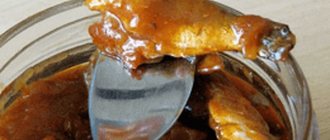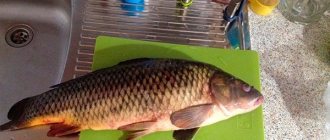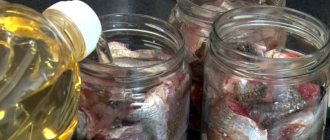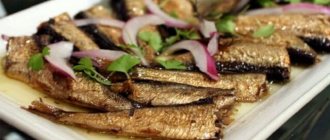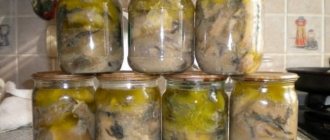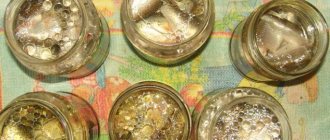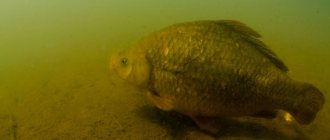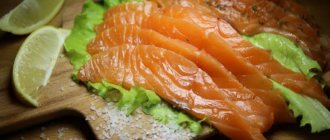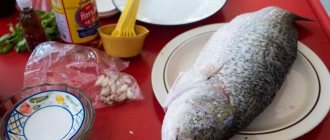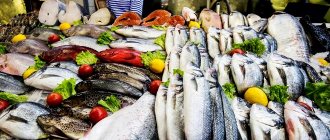Homemade canned fish
Working with an autoclave requires attention. To make canned food tasty, you need to follow certain rules.
- The autoclave operates at high temperatures and under significant pressure, so while cooking stew, you must not move it, drop it, remove the lid, or even just touch it. First, it must complete cooking, then the gas is turned off, and after the tank has completely cooled down, you can open it.
- Large fish, as a rule, have large bones removed, while small fish, such as sprat, are cooked in an autoclave whole and even with the head.
- The dish in the seaming container is laid out so that there is about 2 cm left to the neck, otherwise the lid will be torn off.
Important!
If canned fish in an autoclave is made in oil and fried beforehand, it is not recommended to use breading!
- Water is poured into the machine so that the lids of the jars are covered by 1-2 cm.
- Before putting the autoclave on fire, you need to check the tightness, whether the lid is closed, and whether everything is done correctly.
- Canned fish in an autoclave is made at a temperature of 100-120 degrees. During cooking, it must be constantly checked, otherwise the final result may be disappointing.
Recipe for canned food in oil at home
Also check out these articles
- The best varieties of early cabbage
- What grain to feed laying hens
- Raspberry Hercules
- The best breeds of decorative rabbits for home keeping
Recipe for canned food in oil at home
Fish in oil is the easiest way to make canned fish in an autoclave. You can use any fish for this dish at home. Small ones like sprat are also suitable, but it’s best to take crucian carp, rudd, catfish, silver carp or something similar.
Ingredients:
- Fish – 5 kg;
- Onion – 500 g;
- Carrots – 500 g;
- Vegetable oil – 150 g;
- Salt – 55 g;
- Black peppercorns;
- Laurel – 10 leaves.
Important!
Only rolled up jars can be placed in the autoclave for further preparation!
Preparation:
- The fish is first cleaned, the head is cut off, and the giblets are removed. If the fish is large, it needs to be cut into manageable pieces (to fit in a jar) and salted for 2-3 hours.
- Peel carrots and onions. The carrots are cut into rings or grated, and the onion is chopped into half rings.
- The jars for twisting are washed together with the lids. Peppers, vegetables and fish are placed in layers at the bottom. You also need to put 1 bay leaf in each half-liter jar. Oil is poured on top of the preservation and sealed.
- That's it, the jars are ready, they are placed in an autoclave and cooked at a temperature of 110 degrees for 1-1.5 hours. When cooked for a long time, the fish becomes soft and small bones become less noticeable.
After cooking, when the autoclave has cooled, these homemade canned fish are taken out, dried and hidden in the pantry.
River fish canned in tomato sauce
The shelf life of home-canned fish is 12 months.
In this case, it is important that the temperature regime is within 0... 5°C, and the air humidity is not higher than 75%. Did you know? Some types of canned fish are much healthier than fresh ones. For example, herring reveals its qualities most fully when sterilized with oil and vinegar.
Canned fish can become your signature dish, the recipe of which all housewives you know will want to know. Its advantages are excellent taste, low cost and ease of preparation.
Canned fish in tomato juice will be slightly different in taste, but no less tasty and healthy. The recipe is very similar to that written above, but there are some nuances.
For 1 half-liter jar we will need:
- fish – 350-400 g;
- onion – 1 onion;
- carrots – 1 piece;
- bay leaf – 1 piece;
- black peppercorns – 3 pcs;
- salt - to taste;
- tomato paste – 2-3 tbsp. l.
- The fish must be cleaned, washed and cut into pieces. If you use gobies, capelin or small river fish, then you do not need to trim the fins and tail - it will all boil in the autoclave. We gut the carcasses, wash them, then lightly fry them in a frying pan. This way we can get rid of excess moisture. Then add some salt to the fish.
- Cut the onion into rings and grate the carrots. Fry the vegetables in a frying pan in a large amount of oil. After a couple of minutes, add tomato paste to them, simmer under the lid for about 10 minutes.
- The critical stage is the layout of the products. First, we wash the jars, dry them, and inspect them for integrity.
- We secure the blanks into special cassettes and place them in an autoclave. Fill the container with water, without adding 2-3 cm to the top edge. Turn on the heat and wait until the device shows a temperature of 110°C. After that, time it for 40 minutes. After the time has passed, the canned food will be ready. All you have to do is wait until the autoclave cools down to enjoy the fish delicacy you’ve prepared yourself.
Then put a bay leaf on the bottom and throw in a couple of peppercorns. On top of them we lay layers of fish and our tomato broth. Leave an air cushion of 2-3 cm at the top of the jar.
The tomato sweet and sour sauce gives the fish its aroma and special taste - it contains spices. Fish is prepared from sea and river.
The process begins with cleaning the scales. The carcasses are washed well, the tails and fins are cut off, and fried. Broth is boiled from the cut off parts just like soup.
When cooked, strain, add onions, carrots, tomato paste, bay leaves, vegetable oil, and store-bought fish seasoning. Simmer over low heat.
While the filling is being prepared, the fish is placed in sterilized jars. Pour the filling up to the throat and place it in a saucepan to sterilize for 7-8 hours under the lid.
Place a towel on the bottom of the pan under the jars before sterilization. The jars are rolled up hot. Fish prepared using this method lasts for a year.
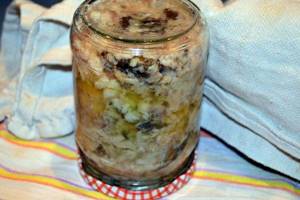
Many housewives do not know how to roll up jars, but in fact this is not a difficult, albeit responsible process. It is necessary to familiarize yourself with the rules in advance so that no problems arise during cooking. So, what every housewife needs to remember:
- Any fish is suitable for preservation: river, sea, small and large. Among the freshwater inhabitants, pike, bream, crucian carp and carp are most often chosen. It is desirable that the fish be fresh, without damaged skin.
- When cooking, you must strictly follow the recipe and use only fresh and high-quality products. In addition, the product is processed on a clean surface, otherwise the canned food may deteriorate during storage. Sterilization lasts about 6-8 hours, but you can reduce the time by repeating the procedure several times.
- Whole jars and new lids are suitable for rolling. Containers that are not tightly closed may explode. Failure to comply with the technology or improper preservation will lead to swelling of the lids and the growth of bacteria. It is prohibited to eat such a product! Good canned fish does not have an unpleasant odor.
Expert opinion
Borisov Denis
Assistant chef of the restaurant "Fisherman's House"
If the seal has been broken or there is no confidence in the correct sterilization of the container, then it is better not to store canned food for a long time. They can be put in the refrigerator for 1-2 weeks and eaten, but they cannot be left for the winter.
Canned fish in tomato sauce tastes like store-bought canned fish. However, there is no shame in serving such a dish as an appetizer, because you can be sure of the naturalness and freshness of the product.
Kitchen utensils: three 0.5 liter glass jars; three iron lids for jars; a ceramic kitchen knife; pressure cooker; wooden cutting board; measuring cup and kitchen scale; spacious deep bowl; device for rolling caps; a warm blanket.
Ingredients
| table salt | 18-20 g |
| small river fish | 900-1000 g |
| deodorized sunflower oil | 130-160 ml |
| Bay leaf | 3 pcs. |
| mixture of peppercorns | 24-30 pcs. |
| carnation | 6 pcs. |
| nutmeg | 3 pinches |
- We clean the fish in the amount of 900-1000 g from scales, then cut off the tail, head, fins and take out the insides. Wash the fish thoroughly under a strong stream of cold water. Cut the carcasses into small pieces approximately 2.5-3 cm wide.
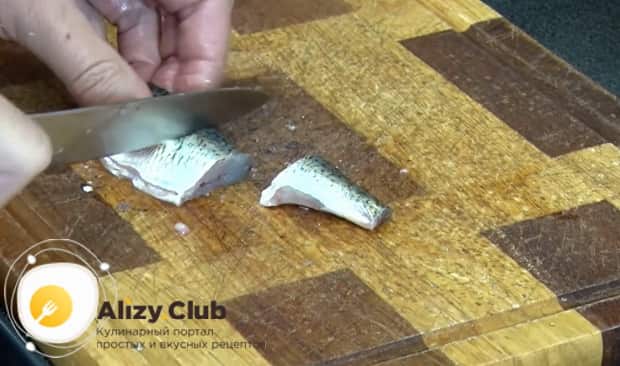
- Place the chopped product in a deep bowl and add 18-20 g of salt there, mix thoroughly.
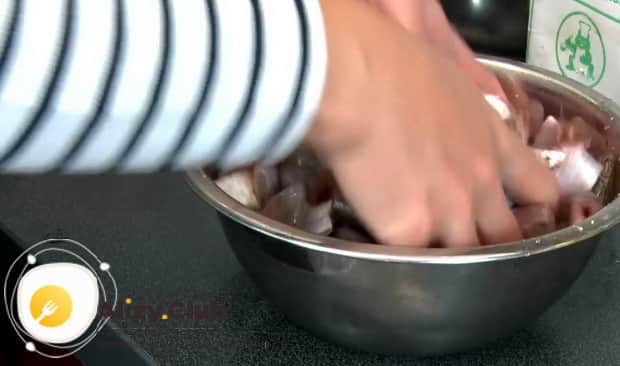
- At the bottom of each jar we place 8-9 peas of a mixture of peppers, 1 bay leaf, a pinch of nutmeg and 2 cloves.
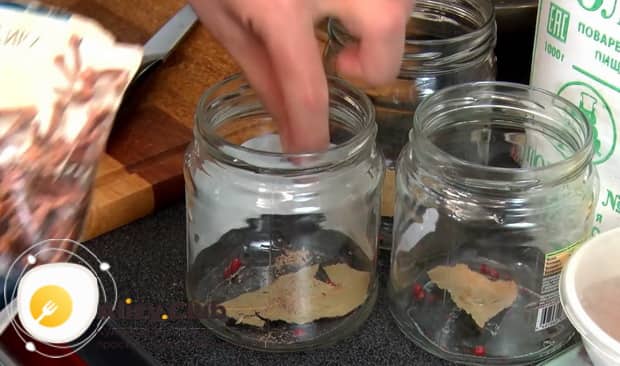
- Place the prepared pieces of fish tightly on top of the spices to the level of the narrowing of the neck of the jar.
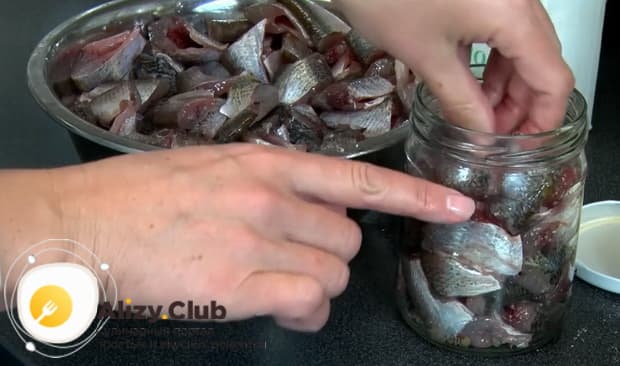
- Pour sunflower oil over the fish so that all the pieces are covered with liquid. Cover the jars with lids and place them in the pressure cooker.
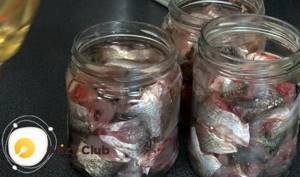
- Fill the device with cold, clean water to the level of the narrowing of the neck of the cans. Close the pressure cooker with a lid and place it on high heat. Bring the water to a boil, then reduce the heat to low. Leave the canned food to cook for 2.5-3 hours. After three hours of canning, remove the pressure cooker from the stove and allow the water to cool completely.
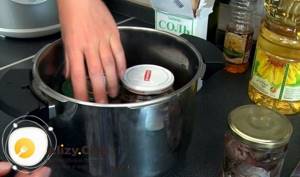
- We take the jars out of the water and roll up the lids using a device designed for this. We send the canned food to a dark place, wrap it in a warm towel and leave it like that overnight. Place the cooled preserves in the refrigerator or cellar for long-term storage.
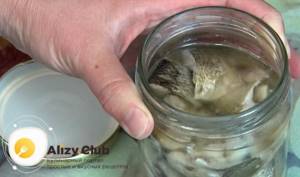
We suggest you read How to grow onion sets from seeds
You can follow the entire process of preserving sprat at home by watching the video below.
- When choosing fish, I advise you to pay special attention to perch, roach, minnows, and ruffs. Canned fish from the listed types of fish will surprise and delight you with their aroma and unusually pleasant taste.
- If you are going to add crushed spices to canned food, mix them with fish pieces rather than putting them separately in a jar.
- Cloves and nutmeg are very aromatic spices that have a specific taste, so don't put too much of them. Added spices in moderation will give canned fish a pleasant spicy taste.
- The recipe indicates the amount of salt to obtain lightly salted preserves. If you like salted fish, then increase the amount of this spice.
Cooking time: 1 day and 10 hours. Calorie content (per 100 g): 92-99 kcal. Number of cans: four liter jars. Kitchen utensils: large-diameter frying pan, preferably with a non-stick coating; wooden spatula with a thin edge; measuring cup and kitchen scale; several spacious bowls;
Ingredients
| table salt | 35-40 g |
| small river fish | 2.8-3 kg |
| premium wheat flour | 90-110 g |
| sunflower oil | 45-55 ml |
| medium sized carrots | 2 pcs. |
| medium sized onion | 2 pcs. |
| Bay leaf | 4 things. |
| black peppercorns | 12 pcs. |
| tomato paste | 290-310 g |
| water |
A simple recipe for canned fish in an autoclave
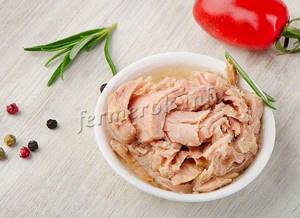
A simple recipe for canned fish in an autoclave
Fish in its own juice is a very tasty and healthy dish. Catfish, silver carp or similar large fish are best suited for this recipe. You can also combine two or more types, for example, fatty varieties of fish with dietary ones.
Ingredients:
- Fish – 3 kg;
- Onion – 1 pc.;
- Black pepper – 9 peas;
- Vegetable oil – 3 tbsp. l;
- Laurel – 3 leaves.
Preparation:
- The fish is cleaned, gutted, and the head is removed.
- Clean fish is cut into medium pieces (to fit in a jar).
- The onion is peeled and cut into rings.
- Spices, onions, and then pieces of fish are placed in washed jars. They are placed tightly so that there is very little free space in the jar. But there must be 2 cm of free space left to the edge of the jar!
- Oil is poured on top of the fish (no more than a tablespoon per half-liter jar) and then the containers are rolled up.
- The rolled containers are installed in the apparatus. Preservation is done for 35-40 minutes at 110-115 degrees. When the autoclave is turned off, you need to wait for it to cool down, remove the jars and store them.
This canned fish does not take long to cook in an autoclave. If the fish is large, you should remove the bones in advance, because they may not have time to cook and will later end up in canned food.
Important!
If you put a little sugar in the can, the fish will not lose its shape and will not fall apart.
Basic Rules
You can prepare canned fish for the winter from any type of river inhabitants, including small fish.
The only difficulty in cooking is cleaning the fish. It needs to be freed from scales, gutted and cut into pieces. Small fish can be left whole carcasses. Canned food is prepared in glass jars; it is better to take a container with a capacity of 0.5 liters. The jars are sealed tightly and stored in the cold. An exception is canned food prepared in an autoclave; such preparations can be stored at room temperature.
Before we talk about preparing canned fish at home, let's talk about the basic rules. Any fish can be used. But usually canned food is made from roach, bream, crucian carp, carp, pike, tench, in general, everything that can be caught in mid-latitude waters. If possible, you can also cook sea fish.
For preparations, use only fish that is externally healthy and undamaged. Only vegetable oils can be added to the product. For example, olive, corn, sunflower oil, you can cook fish in tomato sauce with spices.
To make it convenient to lay out the fish and then eat it, choose small canning jars. The ideal option is a volume of 0.5 to 1 liter. If you cook in the oven, the fish in such containers will also cook well. Don't forget to sterilize glass containers before putting food in jars. To do this, you can hold them in the oven or over steam, and do the same with the lids.
You can use a large saucepan, put a towel on the bottom, pour water and put jars of fish. Water should cover them no more than half. Simmer for 15 minutes, then remove from the pan.
How to make gobies in tomatoes
We recommend reading our other articles
- Summer varieties of apple trees
- Autoclave Belarus Lux
- The best winter pear varieties
- Wheat gluten

How to make gobies in tomatoes
Homemade canned fish is a dish for all times, for example, gobies in tomato cooked in an autoclave are very popular. In terms of price, this dish is inexpensive, but at the same time it can be consumed separately or added to other dishes.
Ingredients:
- Steers – 5 kg;
- Onion – 500 g;
- Tomato paste – 150 g;
- Sugar – 150 g;
- Vinegar – 2 spoons;
- Water – 1.7 l.
Preparation:
- The bulls wash themselves. The giblets, head, and outer husk must be removed.
- The prepared bulls are placed in a large bowl, salted and left for 2 hours.
- Now you need to fry the fish in flour until cooked.
- Chopped onions are fried in another frying pan. When it becomes transparent, add tomato paste and sugar.
- The finished frying is transferred to a pan of boiling water, and vinegar is immediately added. The resulting mass needs to be mixed thoroughly, and as soon as it boils, turn it off and remove from the heat.
- It is not necessary to sterilize the jars in advance, but it is important to wash them thoroughly, as well as the lids. A little tomato dressing (about 2-4 spoons) is poured into the bottom of the jars, then the bulls are placed. When the fish is laid out, the remaining dressing is distributed. It is important to leave 2 cm free in each jar up to the neck.
- The prepared containers are rolled up and placed in an autoclave. The device is placed on the fire and first heated over medium heat so that the temperature on the thermometer reaches 110 degrees. After this, the fire is reduced and maintained at this level for 1 hour.
After the canned fish has been cooked in the autoclave for an hour, turn off the stove, wait until the autoclave has cooled down, and then take out the canned fish.
Canned roach in tomato sauce in a saucepan
Composition (per 1.5 l):
- roach (cleaned) – 1-1.2 kg;
- salt – 20 g;
- onions – 0.3-0.4 kg;
- tomatoes – 1.5 kg;
- sugar – 60 g;
- apple cider vinegar (6 percent) – 60 ml;
- refined vegetable oil – 150 ml.
Cooking method:
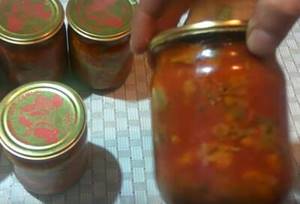
- Clean and gut the roach, remove its heads and fins. Rinse and dry the fish. Cut the carcasses in half. Sprinkle them with salt, stir, leave for an hour.
- Heat the oil in a frying pan and fry the fish in it. There is no need to bring it to readiness, just brown it.
- Wash half-liter jars with soda. After they are dry, spread the fried roach over them.
- Cut the tomatoes crosswise on the side opposite the stem. Boil water in a saucepan, place tomatoes in it, blanch them for 2 minutes. Catch the fruits with a slotted spoon and place them in cold water. Peel the vegetables. Rub their pulp through a sieve or blend with a blender.
- Peel the onion and cut into thin half rings.
- Fry the onion in the remaining oil until golden brown, place it on the fish.
- Add sugar and spices to the tomato puree. Over low heat, bring the tomato mass to a boil, boil for 5 minutes. Pour vinegar into the sauce and stir.
- Pour the tomato sauce into jars.
- Cover the jars with clean lids.
- Place a towel in a large saucepan and place jars of roach on it.
- Pour water into the pan until it reaches the hangers of the jars.
- Over low heat, bring the contents of the pan to a boil. Cook the roach in a water bath for 5-6 hours. Add water as it boils.
- Carefully remove the cans of fish from the pan, roll them up, and turn them over. Cover the containers with a blanket and leave it like that for a day. Cooling in a steam bath, canned food undergoes additional sterilization, which is why it is then better stored.
Recipe for canned fish in broth
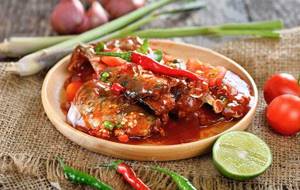
Recipe for canned fish in broth
At home, a wide variety of fish dishes are prepared in an autoclave. This recipe uses a strong broth to pour over the fish. After such canned food sits in the jar for some time, the liquid thickens a little like jellied meat.
Ingredients:
- Silver carp – 3 kg;
- Dill, parsley and celery - 1 medium bunch;
- Tomato paste – 50 g;
- Salt - to taste;
- Black pepper - to taste;
- Laurel - 1 leaf in each jar;
- Water.
Important!
If the temperature in the autoclave is not maintained, the fish will end up either raw or overcooked.
Preparation:
- The fish is cleaned and gutted. A strong broth is brewed from the head, fins, and tail. Herbs, tomato paste, and spices are added to it.
- The fish is cut into medium pieces and fried in breading.
- The washed jars are filled with 2-3 cm of freshly prepared broth. Then they put fish in them. All that remains is to put the laurel and add the broth so that there is still 2 cm left to the edge of the jar.
- This dish is prepared for half an hour in an autoclave at 110 degrees.
Filling recipes
Canned fish acquire excellent taste and aroma when using fillings. The latter can be oil, tomato and broth. In this case, the fish can be preserved in its own juice.
In oil
Fish in an autoclave is prepared at home with the addition of vegetables, spices and sunflower oil. This type of canned food can be used for soups, salads and sandwiches.
To prepare canned fish in oil at home with your own hands, you need to have the following ingredients available:
- bay leaf – 5 pcs.;
- onion – 75 g;
- sunflower oil – 50 ml;
- carrots – 75 g;
- unpeeled fish – 3.2 kg;
- salt – 30 g;
- black peppercorns – 20 pcs.
Step-by-step process for preparing treats at home:
- Fresh fish must be cleaned of entrails, head, tail and fins removed.
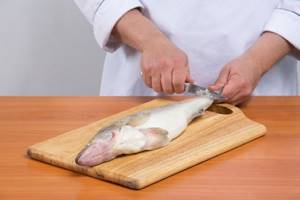
- The carcass should be rinsed well under a stream of water, cut into pieces of 40–50 g, salt and mix.
- Onions and carrots need to be washed, peeled and chopped.
- Place 3-4 peppercorns and a bay leaf at the bottom of the jars.
- Next, you should place the fish up to the middle of the jar, and place a small layer of vegetables on top. After the layer of vegetables, you need to add fish in such an amount that there is about 4 cm left to the top of the jar.
- The last top layer should also be made of vegetables, but so that about 2 cm remains on top.
- Sunflower oil must be added when all components have been placed.
- At this stage, it is necessary to hermetically seal the container and place it in the cassette.
- The assembled cassette must be immersed in the device and the containers must be covered with liquid 2 cm above the top.
- You need to keep the jars at 110 degrees for 30 to 40 minutes.
- At the last stage, it is necessary to cool the device to 30 degrees.
When using large fish to prepare this treat with your own hands, you must first remove the bones from the meat, since there is a high probability that they will not become soft during cooking.
In tomato
Canned fish in sweet and sour sauce will be the best option for storing for the winter.
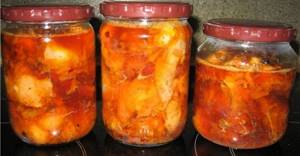
Such canned food is healthier and much tastier than store-bought.
When making canned fish in tomato with your own hands, you should have the following ingredients:
- laurel leaf - several pieces;
- onion – 225 g;
- oil – 700 ml;
- carrots – 225 g;
- flour - for breading;
- peppercorns – 6 pcs.;
- sea or river fish – 2 kg;
- tomato juice – 500 ml;
- salt, sugar - to taste;
- tomato paste – 50 g.
A step-by-step description of the cooking process contains the following points:
- Fresh fish should be cleaned of entrails, washed and cut into portions, first removing the head. Small fish must be preserved whole.
- Next, the fish must be salted and mixed in a convenient bowl.
- After rolling in flour, the pieces should be lightly fried in a frying pan with the addition of sunflower oil, and then placed on a plate to cool.
- Vegetables should be washed and peeled. You need to chop the onion and grate the carrots.
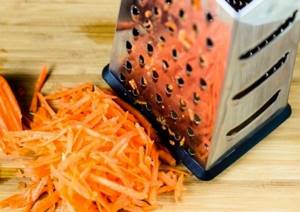
- Next, you need to add sunflower oil, tomato juice, and tomato paste to the cauldron, stewing the vegetables in this mixture for approximately 15 minutes.
- It is necessary to place the fish carcass and fried vegetables in layers in the prepared jars. The jars should be filled as tightly as possible, since the contents of the container decrease in volume during stewing.
- While placing the ingredients in each container, add a bay leaf and 2 peppercorns.
- After sealing the cans, you need to put them into the device and cover them with cool liquid.
- At 120 degrees, jars should be sterilized for 25–30 minutes.
When the device has cooled down, the jars must be sent to a cool place for long-term storage.
In its own juice
Fish prepared for the winter in its own juice turns out to be very healthy and nutritious. This cooking option allows you to preserve most of the vitamins and minerals contained in fish.
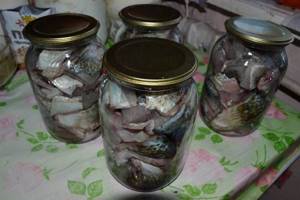
Fish in an autoclave, recipe in its own juice.
To properly prepare a dish at home, you need to prepare the following food products:
- pink salmon – 2 kg;
- laurel leaf – 4 pcs.;
- ground black pepper - at your discretion;
- table salt – 4 tsp.
Step-by-step process for preparing treats at home:
- The fish should be cleaned, the fins and head removed, and then rinsed under a stream of water.
- In each container you should put 1 bay leaf, 5 g of table salt and pepper.
- The fish, cut into 5 cm pieces, should be placed in a glass container, covered with water up to the neck and hermetically sealed with lids.
- At this stage, it is necessary to place the jars in the cassette and send the structure to the autoclave.
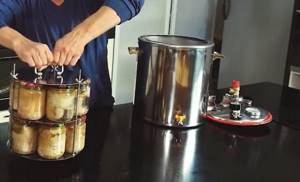
- Cover the autoclave tightly with a lid and cook the fish for 20 minutes. at a temperature of no more than 115 degrees.
- After complete cooling, remove the jars from the autoclave.
Using this method, fish can be preserved in whole batches, because it stores well and will look great on the table at any time of the year.
On broth
Fish in an autoclave at home, prepared with your own hands using a decoction, acquires a rich taste and aroma. During long-term storage, the broth becomes thicker and tastes somewhat like jellied meat.
Composition of components necessary to create these canned products at home:
- parsley - a bunch;
- laurel leaf – 1 pc. on the jar;
- tomato paste – 75 g;
- table salt, pepper - 1 pinch per jar;
- silver carp – 3 kg.
Step-by-step instructions for preparing this dish:
- The silver carp must be cleaned of its entrails and then rinsed under water.
- From these offal you need to prepare a strong broth with the addition of all the ingredients from the list. The resulting broth should be filtered and allowed to cool.
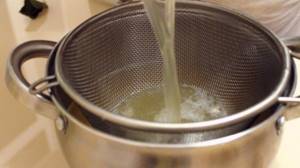
- Prepared and cut fish should be placed as tightly as possible in a container, covered with broth so that about 2 cm remains to the top, and sealed.
- Jars should be sterilized in a device at 110 degrees for 30 minutes.
This type of canned food will be an excellent addition to first courses such as soup and solyanka.
Canned fish in an autoclave with beans
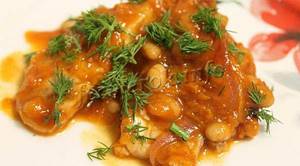
Canned fish in an autoclave with beans
Canned fish with beans is an independent dish that is perfect for lunch and dinner.
Ingredients:
- Pike or gobies – 2 kg;
- Dry beans – 1 tbsp.;
- Onion – 2 pcs.;
- Tomato paste – 100 g;
- Vegetable oil – ½ tbsp.;
- Salt – 45 g.
Preparation:
- The night before cooking the canned food, pour cold water over the beans. In the morning, the beans are washed.
- The pike is gutted, the head, fins, and tail must be removed. The fillet is cut into medium pieces (preferably there are no bones in the meat), and then salted.
- The onion is peeled and cut into cubes, then it needs to be fried in a frying pan. When it becomes transparent, add the tomato and fry the mixture for another 3 minutes. That's it, the tomato dressing is ready.
- The jars are washed in advance. Add a little tomato dressing to the bottom. Then you need to lay the fish and beans in layers. When the jar is full, add tomato dressing, leaving an empty space of up to 2 cm from the edge of the neck.
- Homemade canned fish is rolled up and cooked in an autoclave for 1 hour at a temperature of 110 degrees.
Canned fish in an autoclave turns out no worse than those sold in the store. The fish retains its juice, taste, and remains very healthy and nutritious. These dishes are simple to prepare. The main thing is to find a suitable recipe that the family will like and follow the cooking rules.
How to cook
Everything is prepared much easier in a slow cooker. As usual, you need to start with the fish: wash, gut and remove scales. Cut the carcasses into pieces 3-4 cm in size and place in a multicooker bowl. Next add salt, pepper, bay leaves. Peel the onion, but cut it only into 2 halves and also put it in the slow cooker.
At the end, pour in vegetable oil, vinegar and water, mix everything. The liquid should completely cover the fish. Close the lid, select the “Extinguishing” mode and leave for 4-5 hours. You should not immediately take out the snack - you should leave it for another 10-20 minutes, using the “Warming” function.
